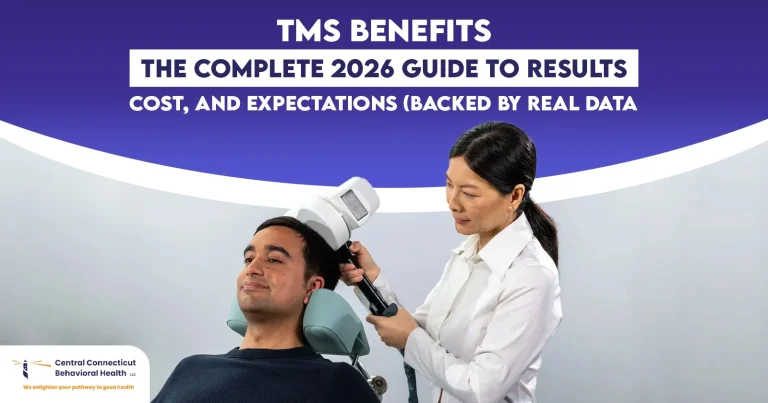When patients begin treatment with buprenorphine, one of the most common questions they ask is how long does buprenorphine stay in your system? It is important to know for those people who are taking medication-based treatment for the addiction of opioids. The knowledge about how long buprenorphine remains active in the body is important for both patients and professionals to monitor the dose, create an appropriate plan that should avoid withdrawal symptoms, and ensuring a safe recovery.
Our professional team at Central Connecticut Behavioral Health provides the individuals with scientifically proven treatment for addiction. This proven strategy includes educating and counselling patients regarding the effects of medicines, their mode of action, and duration to help them decide accordingly.
Understanding Buprenorphine and Its Role in Treatment
Buprenorphine is a partial opioid agonist that binds to the same receptors as opioids like heroin or morphine but produces milder effects. This helps reduce cravings and withdrawal symptoms while minimizing the risk of misuse.
When asking how long does buprenorphine stay in your system, it’s important to remember that several factors—such as dosage, frequency of use, metabolism, and liver function—can influence how long the drug remains detectable.
Buprenorphine Detection Time in Urine
A common method of testing for buprenorphine use is through urine screening. Buprenorphine detection time urine testing can typically identify the substance for up to 7–10 days after the last dose. For some individuals, detection may extend longer depending on metabolism and hydration levels.
At Central Connecticut Behavioral Health, urine testing is often used as part of ongoing treatment monitoring, helping ensure medication adherence and treatment progress.
How Long Does Suboxone Stay in Your System?
Since Suboxone contains buprenorphine and naloxone, patients frequently wonder how long does Suboxone stay in your system compared to buprenorphine alone. It comprises the same answer that Suboxone is detected in urine for a week after being used last time, but in chronic cases, it can be detected for a longer time.
This information helps patients plan their recovery timelines safely under medical supervision.
Buprenorphine Blood and Hair Detection
These detection methods vary from person to person. After last use, the buprenorphine blood test window results can be seen for 2-3 days, but in the case of buprenorphine hair test detection, it may extend to 90 days because the drug particles embed in hair follicles with the passage of time.
These tests are not necessarily used in routine care but are helpful in forensic and clinical findings.
Other Factors That Affect Detection Time
There are certain factors (biological and lifestyle) what affects the Buprenorphine detection time, such as:
- Metabolism rate: Faster metabolism reduces detection time.
- Hydration: More fluid intake may shorten detection windows in urine.
- Liver health: The Liver metabolizes buprenorphine so, it may extend there due to impaired liver functions.
- Dosage and frequency: High dose intake will lead to long-term detection of the drug in the body.
Each patient’s situation is unique, so results can differ significantly even between individuals on similar treatment plans.
Half-Life of Buprenorphine
It takes 24-42 hours for the buprenorphine to leave the body (buprenorphine half-life). This long half-life of buprenorphine makes it provide sustainable relief from symptoms and change in dosing under expert supervision.
This is the key feature of medicines that has made them vital for the treatment of opioid use disorder at Central Connecticut Behavioral Health.
Understanding Norbuprenorphine Levels
Norbuprenorphine urine levels are also marked while checking for buprenorphine. This monitoring indicates that how does body metabolize the drug. Norbuprenorphine is an active metabolite of buprenorphine which makes it stay even longer in the body, helping professionals to evaluate treatment safety and progress.
Final Words
For the individuals thinking about how long does buprenorphine stay in their system, the answer simply depends on its dose, frequency, testing techniques, or the body type. It does not matter for how long buprenorphine can be detected in urine, blood, or hair, it will still remain an effective medicine with reduced side effects if handled by experts.
At Central Connecticut Behavioral Health, we help patients use this treatment responsibly and effectively—always prioritizing health, safety, and long-term recovery. Our professional team makes sure to guide you with compassionate care and lasting recovery.
FAQs
-
How long does buprenorphine stay in your system?
It usually stays in urine for 7 to 10 days depending on the dosage and body metabolism.
-
How long does Suboxone stay in your system?
How long does Suboxone stay in your system is usually around a week but can extend longer in frequent users.
-
What affects buprenorphine detection time?
The function of the liver, the time for metabolism, and water intake are the factors influencing what affects buprenorphine detection time.
-
How long does buprenorphine show up in a blood test?
The blood test window for buprenorphine is 2 to 3 days after the last time of use.
-
What is buprenorphine’s half-life?
The buprenorphine half-life is longer, comprising 24 to 42 hours, which makes it last longer in the system.














